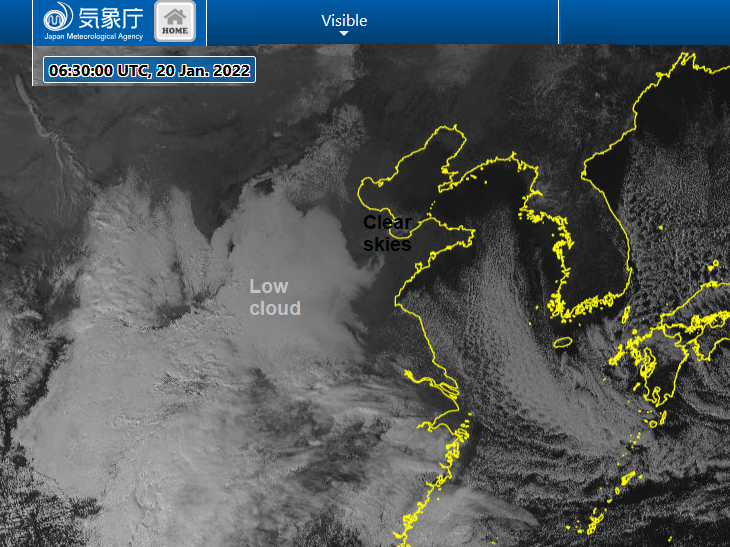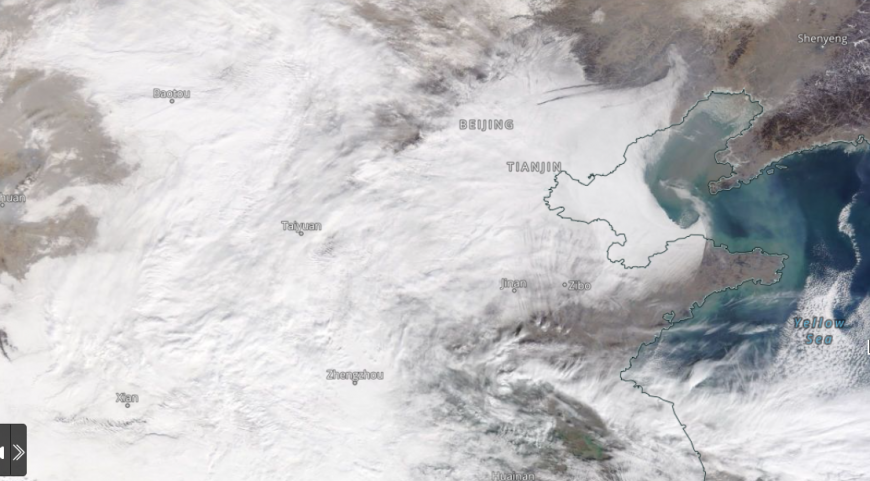
The first snow of 2022 fell on Beijing on January 20th with just two weeks until the start of the Winter Olympics in China and another thin covering on Saturday 22nd. China has moved into the final solar term, one of 24 parts of the calendar year, known as ‘Dahan’, the major cold. This leads up to Lunar New Year on the 1st February with the Opening Ceremony being on the 4th. There were ice warnings for the capital and sub-zero temperatures as the China Meteorological Administration (CMA) “mobilized their meteorological services for the 2022 Olympic and Paralympic Winter Games” but not enough snow for the Olympians. The snow cannons have been working overtime.
The weather is often a feature for the Olympics. The delayed summer Games in Japan started with a Typhoon on the way, Neparatak. There was searing heat and no public audience due to the pandemic. The last winter Games in Korea, PyeongChang 2018 had a very cold start. Extra winds shields were erected and heaters had to be brought into the stadiums. There have been growing concerns about the number of viable locations for the winter Games in the future as our climate changes. Artificial snow is becoming the norm.
Like many parts of the world, last year was China’s hottest year on record. The CMA said that the average temperature in 2021 was 10.7C. The highest since 1961 when records began.
Beijing and northeast China has an arid climate. A huge high pressure dominates the winter weather bringing dry, settled conditions. In the resulting northerly wind, cold air feeds down from Mongolia and Russia. Early February would typically see temperatures ranging between +4 °C to -7°C. Beijing can see lingering low cloud and greyness underneath the stagnating high pressure. Much like our own endless anticyclonic gloom here in the UK. This adds to the cold winter feel. Air pollution is often a problem. The Asiatic monsoon (seasonal winds) bring the cold, dry winter in the north but rains to the south for summer. Moisture comes off the Pacific Ocean and South China Sea but northern China does stay drier. All of this doesn’t give much snow for the Winter Olympics. A situation that has cropped a few times recently. For China, the desert mountain ranges in the north were looking brown and bare at the beginning of winter, even after an early snowstorm at the start of November 2021.

Cloud cover from JMA on 20th Jan
Last winter, Beijing saw wild fluctuations in temperatures in early 2021. On the morning of January 7th, Beijing had set a new daily cold record with an icy -19.6C. Later in February, it was unusually warm. 25.6 C (78F) on the 21st which was the highest temperature ever recorded in Beijing during the winter months. It was more typical of mid-May. This might have added more stress for the organisers with a year to go.
There are three zones or clusters for the various venues. The main area and village in Beijing, then towards the mountains, Zhangjiakou away to the NW of Beijing and the nearer suburban Yanqing.
An International Olympic Committee evaluation report said that Zhangjiakou and Yanqing - the Games zones hosting alpine skiing and snowboarding, among other outdoor events - “would rely completely on artificial snow”.
The Alpine competition will take place at the National Alpine Ski Centre in the Yanqing competition zone; events such as Downhill, Super-G and the Giant Slalom. The Nordic combined competition will take place at the Zhangjiakou competition area with the National Ski Jumping Centre, National Cross-Country Centre and also National Biathlon Centre.
In Beijing, many of the 2008 summer Olympic venues have been adapted. There is the National Speed Skating Oval (also known as the Ice Ribbon), which was former Hockey and Archery fields. Curling will take place at the Beijing National Aquatics Centre, once known as 'The Water Cube'. Now 'The Ice Cube'
The Wukesong Sports Centre (previously Basketball) and National Indoor Stadium (rhythmic gymnastics, trampoline, and handball in 2008) will share hosting duties for the ice hockey competitions at Beijing 2022.

cloud cover from NASA World View by 21st Jan
Covid and politics have already thrown issues at Beijing 2022. Attendance for these Games has been hit in many areas. China has just cancelled plans to sell Olympic tickets to the public as the number of COVID cases continues to rise. Athletes, support staff, volunteers and the media will all be kept in a tightly controlled "closed bubble" away from the rest of the population. Some competitors such as players in the NHL (National Hockey League in North America) have decided not to participate in the 2022 Olympics because of disruption to their league season because of COVID.
Darren Kilfara, ice hockey commentator for Olympic Broadcasting Services in Beijing, explained that “unlike in Tokyo, where it was possible after an initial quarantine to do some sightseeing and use public transportation, no-one will be able to leave the Beijing closed bubble during the Games – I’m really excited to be involved, but I really wish the Olympics could have happened under different, better circumstances”.
For those attending the air will be very dry and cold, the snow artificial and sightseeing opportunities minimal. However, the Olympic spectacle continues. Watch out for the Olympic mascot, a giant panda named Bing Dwen Dwen. In Mandarin Chinese, "Bing" has several meanings, though the most common is ice. The word also symbolises purity and strength, while “Dwen Dwen” means robust and lively, and also represents children.
Bing Dwen Dwen wears a full-body “shell” made out of ice. The shell helps the panda to skate, snowboard and ski alongside the Olympic athletes. The bright colours of the halo around its face are a representation of the latest advanced technologies of the ice and snow sport tracks at the Games.
The Paralympic ‘Glowing Lantern’ mascot is named Shuey Rhon Rhon. Shuey has the same pronunciation as the Chinese character for snow.
Loading recent activity...